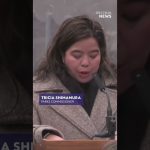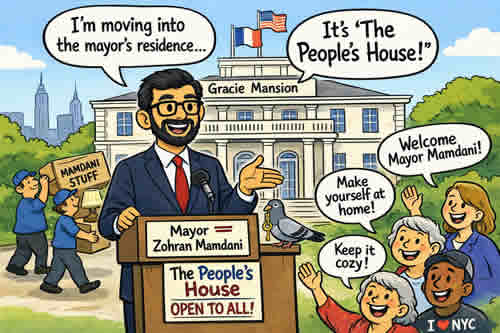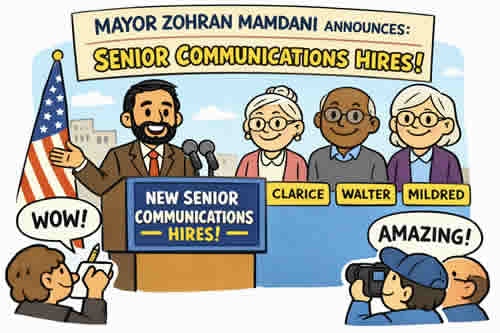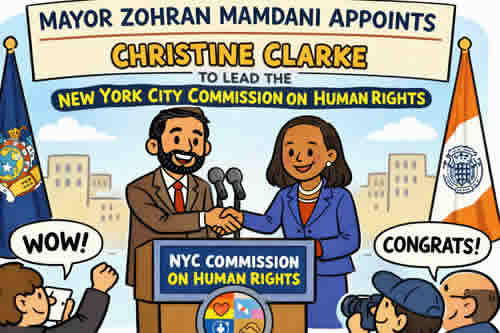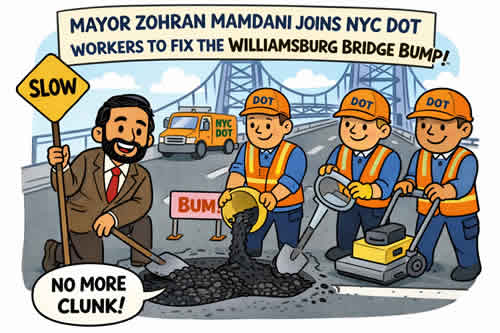Deputy Mayor Fabien Levy, Communications: Good afternoon everybody. I’m Fabien Levy, deputy mayor for Communications, and thank you for joining me this week for the asylum seeker briefing. Don’t worry, my very better half, Deputy Mayor Anne Williams-Isom will be back very soon. Joining me today are Dr. Ted Long, senior vice president at New York City Health and Hospitals, and Zach Iscol, commissioner of New York City Emergency Management. I want to start today by sharing a sobering update.
As of this past Sunday, more than 100,000 asylum seekers have entered our city and asked for care since last spring, more than 101,200 men, women, and children, have come to New York City seeking a better life and needing our help to get there. To put that in perspective, this population is larger than the entire city of Albany. New York City is a city of immigrants, immigrants like many of your families, and just like my family who came here from the Middle East almost 50 years ago in search of the American dream, but never before in our city’s history have we seen such a concentrated influx of asylum seekers.
As the number of asylum seekers in our care surpasses 58,500, just yesterday, we opened a new humanitarian relief center to serve adults seeking asylum. In partnership with New York State, the city has constructed and opened a humanitarian relief center that will serve approximately 1,000 adult men seeking asylum in the parking lot of the Creedmoor Psychiatric Center in Queens. We’re grateful for the state support in providing this space and for their commitment to reimburse the city for all costs of this site, including construction, maintenance, and staffing. The city has already spent more than $1.73 billion on this crisis. We’ll spend an estimated 5 billion this fiscal year alone. And as we laid out last week, we expect to spend more than $12 billion over three fiscal years if things do not change and we do not receive additional federal and state help. So we need more, more from our state partners and more from our federal partners.
Before I turn to Dr. Long to delve into details of our new humanitarian relief center, I’ll share the latest data on this crisis. As of August 13th, we have a total of 110,200 people in our care, including over 58,500 asylum seekers. Again, since last spring, we’ve had more than 101,200 people come through our shelter system seeking asylum. We’ve opened 201 sites, including 13 humanitarian relief centers. However, I would note that the Creedmoor facility that opened yesterday was number 14, and we still have two more to open soon. And last week from August 7th to August 13th, we had more than 2,700 asylum seekers enter our system. We continue to see these high numbers week after week, despite reports of decreases at the border, likely due to secondary migration. Let me now turn it to Dr. Long to discuss a few details on the new relief center at Creedmoor.
Dr. Ted Long, Senior Vice President, Ambulatory Care, New York City Health + Hospitals: Thank you, deputy mayor. Our new site at Creedmoor can house 1,000, but 1,000 is more than just the number. Each time we care for a thousand asylum seekers, that’s a thousand individuals who all have their own story and a thousand people that this year will celebrate their birthday safely and free from fear and persecution. That includes amputees that have made the journey all the way here to New York City. That includes pregnant women who have made the journey here on foot motivated by their strong desire to create a better life for their children. That includes police officers who in their home country did the right thing. And as a result, had their lives threatened and had the lives of their families threatened. That includes women who experienced female genital mutilation and are here with their young children today because they will do everything to protect their daughters from experiencing the same trauma that they experienced when they were children themselves.
This year, helping 1,000 people is enabling those 1,000 birthdays to happen free from fear because of what we’ve done here in New York City. Now specific to Creedmoor, at Creedmoor, we’re going to be able to care for 1,000 adult single men. It’s important to talk about Creedmoor because it shows how we’ve looked at sites over time. For the duration of the crisis, we’ve sought every opportunity, and Commissioner Iscol will tell you, we’ve looked at thousands of sites across New York City about existing opportunities for housing people appropriately. We’ve now exhausted those options. So, we’re at the point and Creedmoor shows this of having to create new options in parks and parking lots.
To walk you through briefly what the experience for somebody at Creedmoor will be. If you’re a single adult man, you’ll come on site. We’ll do the intake process with you. We’ll ask you the same questions that we’re asking everybody as part of the check-in process for asylum seekers coming to the Arrival Center today. We’ll screen you for communicable diseases. That includes active tuberculosis, Covid, varicella. We’re then going to give you an ID badge with a QR code to scan in and out of the facility, and we’re going to give you a 60-day notice. But immediately when we do that, we’re going to pair that with an immediate conversation with one of our caseworkers so that from day one we can establish what your goals are, and we can do everything in our city’s power to help you to achieve those goals quickly so that you can take the next step forward in your journey. Opening Creedmoor for the 1,000 adult men has 1,000 new opportunities to safely and free from fear have birthdays this year and our asylum seekers deserve that. Thank you.
Deputy Mayor Levy: Thank you Dr. Long and thank you for you and your team for everything you’re doing in this crisis. Again, we want to continue to ask for more support from our federal and state partners because we know that it will take all of us to solve this national issue. With that, I’ll open to some on-topic questions.
Question: The letter from the state — I know the mayor talked about it a little bit earlier today — but my first question is can somebody talk about why the locations that were offered up from the state in particular were rejected by the city? What was wrong with them, with the aqueduct, with the gymnasiums, with their armory? Just talk a little bit about those details. Was there not enough space? Were the beds not going to fit or the cots? Just some more details about that.
Deputy Mayor Levy: Sure. So, we’re reviewing the full letter right now and we can get back to you on more details about specific sites. I would first like to point out we’re very appreciative of the state’s collaboration with us every single day. We are also very appreciative that it sounds like in that letter that the state wants to do more and we very much welcome that. So, over the last year, we have put over 100,000 people in shelter. We’ve opened up over 200 sites, and if the state has more sites that they feel like we should be looking at, we’re happy to do so. Commissioner Iscol can speak a little bit about what we’re looking for at sites.
Commissioner Zach Iscol, New York City Emergency Management: Is this on? Great. Yeah, so I have not had a chance to review the full list of sites, but with every site, and you’ve heard me talk about this before, there’s a whole host of things that we need to solve for. Sometimes it’s the economic impact, sometimes it’s the impact to the community. There’s a number of sites that have significant community impacts. There are sites that have environmental factors like flooding or those types of issues that need to be dealt with. There are some sites that are only seasonally available because of use, whether it’s cruise ships or sports or other things of that nature. And so, as we look at different sites, those are all things that we need to solve for, but as Fabien said, happy to see the state engaged and looking forward to working with them more in the future.
Question: Last week, Mayor Adams and the budget director talked about potential cuts to services provided to asylum seekers. Has the city finalized its plan and what types of cuts should people expect to see, whether it’s food security, or social workers? Tell me a little more about that.
Deputy Mayor Levy: Sure. So, I think one thing to remember is the mayor and the budget director made very clear the cost will be $12 billion over three fiscal years if things do not change. We need things to change. We are going to make things change on the city level. We need our state and federal partners to do a little bit more so that we do that. $12 billion is not an acceptable number, and so we’re going to be looking at changes both on the city level. That’s one of the things he talked about, cost savings. So, we’re doing a full analysis of all the different costs, but we need the state and federal government to offer us more. And if they do, that’s how we bring the number down from 12 billion. So, we don’t have a specific number of service to say every city service will be affected if we weren’t to do that.
Question: So that was from last week. So, this week there’s no update as to what those cuts could be, where those cuts could be seen. And as you continue to help open up parks and facilities, how will you save money elsewhere?
Deputy Mayor Levy: So like the mayor said, we’re looking at a full analysis of that, but we need more from the state and federal governments and we’re doing that.
Question: Dr. Long, you mentioned folks are getting 60-day notices. Where specifically do you expect them to go after 60 days? Are they going to be renting their own place? What if someone doesn’t have a place to go?
Dr. Long: Yeah, that’s a great question. So, the most important thing about this 60-day notice process is our new ability, new opportunity, to have an engaged conversation now, to see what people need now at this point during the crisis. Case management is going to be one of the most important things we do moving forward. I’ll give you an example.
When we started to do the 60-day notices, we had sit down conversations face-to-face with our asylum seekers, and 65 percent of them were able to tell us, “Yes, I’m ready today to make an exit plan, but I need your help with something in order to succeed in doing that.” Some examples of what that something was were IDNYC, OSHA training, learning to speak English, things like that. They communicated to us that if we could help them with those things, then they would be able to take the next step forward in their journey, leaving our city system. So, our goal now is to have the most concerted effort humanly possible to help them to achieve their goals that they’re telling us they need help with.
Question: So why give them a 60-day notice? Can I just ask you, why give them a 60-day notice if they’re going to have their plan anyway? Is it to just get them out?
Can you just answer that question please? And then we can move on.
Deputy Mayor Levy: I can jump in here. We were very clear during the announcement when we made, part of the 60 days is the focus on the intensified casework. That’s what we’re really focusing on, and we haven’t hit the 60 days, but a lot of the people that we’ve talked to, the intensified casework is working. And I point out, we talked to you about 101,000 asylum seekers have come in, but what did I say? 58,500. My rough math. There’s over 42,000, 43,000 people who have left. Some of those because of intensified casework, some because they just found their own place. Lots of people are moving on on their own.
Dr. Long: And if I can add… Can I just add, now that we’re answering your question. A really, really important point here is just to back up for a second. What is casework case management? Basically, in medical care, I figured this is what I do in primary care. I listen to people and on the medical side, I figure out what they need and how I can help them or make referrals so they can get what they need. Same thing goes for asylum seekers and case management now.
The difference from prior to current, is in current, this gives us an opportunity to have a sit-down conversation proactively with everybody… where using a lot of the same case managers that you may have walked by for the last 2, 3, 4 months, but today they’re not going to let you walk by. They’re going to grab you and they’re going to say, “Let’s have a conversation to establish your goals and figure out how we can help you to achieve your goals.” I think the most important thing to remember is this is a very proactive or intensive approach to helping people identify what they need and then our job is to help them to achieve their goals.
Question: I’d like to follow up on the letter, and I’m wondering, after reviewing the content of that letter, we’ll seek a better level of understanding with the state, just so this doesn’t turn into a major clash between the city and the state…
Deputy Mayor Levy: Seek a better what?
Question: Seek a better level of understanding. Will you seek better coordination with the state, just so this doesn’t escalate into a major clash between the two?
Deputy Mayor Levy: I don’t think there’s any kind of dispute here. Just to be very clear, the governor and the mayor have a great relationship. I have a great relationship with my counterparts. A lot of us, we have good personal relationships with our friends in the state. We are very happy that they’re willing to step up and do a lot more. Remember, over the last year and three months, four months, we have put 101,000 people giving them shelter, food care and more. And we have been asking for additional state and federal help since last year, so we’re happy to hear that they want to do that and we will communicate every single day like we have been doing.
Commissioner Iscol: Can I add something to that, Fabien?
Deputy Mayor Levy: Sure.
Commissioner Iscol: Excuse me. Can I add something to that, deputy mayor?
Deputy Mayor Levy: You’re welcome. There you go.
Commissioner Iscol: I think just one thing on that, the mayor has made very clear to us that the problems that we’re dealing with, whether it’s the asylum seeker crisis or otherwise, are bigger than politics and that we are going to work together to achieve the outcomes that New Yorkers deserve and the people in our care.
Question: Yeah. Back to 60-day notices, in the city’s letter to the state, in the Callahan case, there’s a request to extend 60-day notices to people in DHS facilities, which would be a new extension. If you were to do that, would that only be for asylum seekers? It mentions both adults and adult families. How would you prevent getting into the general shelter population issuing those 60-day notices? Because it does indicate a sort of expansion of that practice. On top of that, I was hoping to get an update on how many notices have been issued to date system wide.
Deputy Mayor Levy: Sure. So, I’ll go backwards. System-wide, over 2,900 60-day notices have been issued so far. And remember, those with intensified casework, so over 2,900 people have had more intensified casework over the last month or so since we started this program. Remember, we have not hit 60 days, so nobody has hit that mark at that point.
No. This would only apply to asylum seekers, not to longtime unhoused New Yorkers. Remember, the majority of our asylum seekers are still currently in our DHS system. We have their DHS system, we have our health and hospital system, we have our respite centers, which are part of New York City Emergency Management, so this would only apply to asylum seekers.
Question: What’s the city’s plan for getting kids into schools? Do you have any DOE representatives going into shelters or HERRCs to talk to families and what’s the plan? Are families and kids just going to show up on the first day of school or do you have enrollment numbers? And also, what is that if you have it?
Deputy Mayor Levy: Sure. So, I think you’re talking about in here in New York City or…
Question: Yeah. In the city specifically [inaudible] if you have any info on plans outside.
Deputy Mayor Levy: Absolutely. So as of the last time I checked, we can get you an updated number. Remember, and just to caveat this, the numbers we always give out are those in temporary locations, so it’s not just asylum seekers, but those longtime unhoused New Yorkers as well. It was over 18,000 that had come in from last July through the present. We can get you an updated number on that. But no, we do plenty of intensified casework with them and make sure that they can register for school. That was one of the big services at our navigation center that Dr. Long was able to…
Dr. Long: If I could just add onto that. Just a quick anecdote. I remember the first humanitarian center we opened the Row for families with children, and DOE proactively was there with us on day one. There was one DOE representative. They set up an office. We welcomed families there, and there was a line around the block. It was something that was such in high demand for families as a way to help their children to acclimate to this incredible journey they’ve been through and to start to deal with the trauma they’ve experienced as well.
DOE immediately expanded their workforce there and we’ve enrolled thousands of children in school at each of our humanitarian centers. Worthy of note too, as part of that process, we’ve had a holistic look at this. Not only is DOE onsite at our humanitarian centers enrolling kids, which will soon be in anticipation of the next school year, but we offer vaccinations. We’ve completed more than 30,000 vaccinations. We have kids coming without varicella vaccinations, without MMR. So, families with children need a great deal, but I think enrolling them in school has been one of the most important things we’ve done. You see a change on their face and they’re going to the bus every day, and DOE has done an incredible job of that.
[Crosstalk.]
Commissioner Iscol: We don’t have any children on our sites.
Question: The state’s letter was saying that there’s this unused pot of money from the state legislature. There’s about, I don’t know, over $750 million left over and the city hasn’t been properly submitting its receipts for this money. Did the city not submit its request for this money? And if so, why was this pot of unused money when we had migrants sleeping out on the street?
Deputy Mayor Levy: Sure. So, I think… Take us back and remember how the money is actually allocated. And again, first I would say thank you to the governor and the state for allocating up to $1 billion for reimbursement for us. Remember when the budget passed, it’s $1 billion at 29 percent reimbursement rate. In order to get $1 billion, we really have to spend somewhere in the $3.4 billion range. So, what we do is we submit reimbursements based off the invoices we get. We’ve been invoiced for about $440 million.
We’ve submitted those invoices to the state, and 29 percent of that is $130-something million that the state has done. All the invoices, we do it once a month. This was part of the negotiation with OTDA, which is a state entity. Once a month we give them our invoices. We did that. And so that’s what we’ve gotten. We’ve given them the invoices that we’ve had.
Question: But if there’s this unused pot of money, why wasn’t that just tapped into or call made in order to get some of those people off the street?
Deputy Mayor Levy: Right. Again, we have to be invoiced in order to get the money, and so we’ve submitted the invoices. The state’s not going to provide reimbursements before they get the invoices.
Question: But they said they did in the letter. They said they already…
Deputy Mayor Levy: They gave $250 million as an advance and we very much appreciate that. They gave $250 million in advance, the rest of the money we have to submit invoices for. As soon as we get them, we’ll absolutely submit them.
Question: In the state’s letter, they say that they advance the city $250 million.
Deputy Mayor Levy: I already…
Question: I know that’s what you’re talking about, but they also said that they are providing this money despite what they call substantial questions about what they’re calling the city’s decision to allow hundreds of migrants to sleep on the street. They’re calling it a decision. Despite the fact that there were hundreds of vacant beds in the city’s shelter system at the time. Was it a decision? What do you think about the state calling it a decision as opposed to a necessity or the fact that you were out of space? And were there vacant beds in the homeless shelter system at the time that you could have used for those people?
Deputy Mayor Levy: Again, I think I’ve been very clear about the numbers, but 101,000 people have been provided care. In the last year, over 200 sites opened up. And we’ve been very clear, we’re at our breaking point, we’re past our breaking point at this point. The city’s shelter system would’ve never expected to have done that. And remember, I think I said 110,000 total people that are in our care between asylum seekers and longtime unhoused New Yorkers, and there are more asylum seekers in our care at this point. Any implication that the city would keep people from beds that could serve them appropriately is not only… And again, this is not on the state, but anybody who’s making this implication, it’s not only mistaken, but also not thinking about the thousands of people here in the city that are working tirelessly in order to provide shelter to these folks.
The asylum seekers and the longtime unhoused New Yorkers are very distinct populations, and so we have different services for them because they don’t mix. We try not to put them in the same population, so we have to have space available for longtime unhoused New Yorkers and the services are offered are very different. Ted was talking about this. Dr. Long was talking about this a little bit yesterday during the tour, if you want to talk about maybe just a little bit of difference of services.
Dr. Long: Yeah, and I’ll start off by saying, as you know, the line broke my heart. We will do everything in our power to prevent that from ever happening again. I’ll also say that the only way that we can have a degree of certainty that we can avoid a line like that in the future is if we get the help from the state and the federal government that we’ve been asking for. And I’m thankful to be able to say today that for Creedmoor and our new site at Randalls, we are getting the help from the state that we’ve asked for. Those sites will make an enormous difference in terms of our ability to place people and give them the specific services that they need.
In terms of what those services are as the deputy mayor was alluding to, we’re seeing so many asylum seekers coming in with trauma from the journey with depression based on the trauma they’ve experienced or with what happened to them in their countries of origin. We’re seeing people come in that are unvaccinated, adults that have never had varicella, children without MMR were able to even at the Arrival center, correct so many of those inequities that they’ve experienced so far, and that’s why we’ve done, again, more than 30,000 vaccines. We screen everybody for depression and immediately connect you to a social worker if you screen positive for depression, which is the standard of care that I apply for my personal patients in the Bronx where I practice every Friday at Morrisania.
So we’re continuing to do everything we can, everything within our power, but the single most important thing for us in terms of avoiding the line right now is to get continued support from the state and support from the federal government to give us the resources and placement options that we need in order to give people an opportunity to stay with us, to avoid being in a line.
Commissioner Iscol: I just want to add one thing to that. I mean, Dr. Long spoke a little bit about some of the differences between different beds and that a bed is not, a bed is not a bed, but the only thing I would add to that is for anybody who would make that accusation against the city, I’d invite them to see what this city does on a daily basis that’s fueled by a deep sense of purpose and humanity to keep people off the streets. What I see on a daily basis being done by the teams at Health and Hospitals, Department of Homeless Services, my agency, HPD, and a host of others, is simply heroic. Every single day, finding places for three to 500 people for months on end 24/7.
And so the idea that people who work for the city are fueled by a deep sense of care and concern for other people, that we would somehow make a decision to leave people on the streets in the face of seeing what the city has done, I’d invite anybody who would make that accusation to come see and what we do on a daily basis to keep that from happening.
Question: Even though the city has been doing a lot in order to provide shelter and basic services to asylum seekers, there is a reality. They only have one year in order to submit their application in order to apply for that. But when we talk to people, a lot of them, they said that they haven’t even been able to get a lawyer. My question is, how many of those 58,000 currently that you are giving shelter have already applied for asylum, and what are you going to do in order to make sure that everybody is going to submit the application before one year?
Deputy Mayor Levy: Absolutely. Thank you for that question. I think that’s actually a really important one, and I’m glad you brought that up. So, we launched the asylum application help center a little over a month and a half ago or so, and in the first five weeks, six weeks since it’s been, we’ve now helped submit over 2,200 applications already. 2,200 applications. These are people that didn’t know how to submit their applications, and our team helped them do that. We had volunteers from law firms across the city coming together and helping us submit those applications. And as you heard, I think about two weeks ago, Deputy Mayor Williams-Isom said that we’re now going to be partnering with a bunch of law schools across the city so that we can do the next phase of this in the fall. So, we’re really excited about that.
That’s how many we’ve helped. Obviously, people can do it on their own, but that is one of the big problems we’ve seen is that people just don’t know how to navigate the legal system. It’s a very complicated process, and we understand that. I mean, even as a born-and-bred New Yorker, if I look at a legal form, I could get confused by it. So, I could only imagine how asylum seekers are feeling. So, we’re doing our best to try to help out. We’ve talked to the federal government about this ourselves actually, and they said they were pretty impressed to our numbers how quickly we’ve moved.
And one other thing we’ve heard from them is that if folks before they cross the border, go through the CBP One, the app, it’ll expedite the whole process. So, I would recommend looking into that and calling the Department of Homeland Security and finding out more about that.
Question: Thank you. I want to circle back on what you said about the migrants who were sleeping outside of the Roosevelt. I understand that you’re saying that there are different beds in the shelter system that you prefer to set aside for homeless New Yorkers and others that you prefer to save for migrants, but there were beds available in the system during those nights when migrants slept at the Roosevelt. I understand that you have an ideal scenario that you set certain aside for homeless New Yorkers and others for migrants, but if there are people sleeping on the streets for five nights, can’t you break that rule in order to house them? Is it better that they’re sleeping on the sidewalk?
Deputy Mayor Levy: So, I would take some issue with what one thing that you just said, what’s ideal. None of this is ideal. None of this is ideal. None of this is even good. This, we’re barely scraping by and we just need more support. And so what we did was we ensured that the beds that could serve them appropriately are being utilized. There are different services and different needs for different populations, and so what was appropriate for them, for what they need, that’s what we were providing.
Question: So, you’re saying it was more appropriate to leave them on the side?
Deputy Mayor Levy: I’m saying that we took the appropriate steps.
Question: I have a question, and I’m seeking clarity with regards to Mayor Adams when he requests that asylum seekers be granted work authorization. My question for that is he just saying asylum seekers or what about the hundreds of thousands of currently undocumented New Yorkers who are here who are paying taxes with their tax identification number is Mr. Adams, or is the Adams administration including the other undocumented New Yorkers in that request, or is it simply exclusively for current asylum seekers?
Deputy Mayor Levy: So, I’m not a lawyer, but I didn’t know that undocumented immigrants can have tax ID numbers, so I will look into that. I apologize. I’m just not up to date on that. But what we’re talking about here are asylum seekers because the asylum seekers have been paroled into the country by Customs and Border Protection. So, they have papers, and part of the process is if they submit their asylum application, then they can become at some point eligible for work authorization. These people came here for a chance at the American Dream, just like I said at the beginning, like my parents did. Let’s give them a shot at it on the undocumented. I can look back into it for you.
Question: Thank you. Going back to the state’s letter noted that the state has committed $25 million to a resettlement program to provide a year of housing for 1,250 households outside the city, and that the city has put forward 252 households that could be eligible and only 17 of those I think said that they were willing to move. Can you talk more about your involvement in that settlement program, and why you haven’t been able to identify more households to participate?
Deputy Mayor Levy: So, we’re appreciative of the state partnering with us. I believe that was a program that was laid out in the Asylum Seeker Blueprint, I think, right? Yeah. So, it’s a state program. The city’s only role is providing referrals. And so we’ve provided these referrals, which we have done. Obviously, the state has asked for initial pilot of, I believe, 15 in June and share the terms and conditions for participation. And so we want to continue to work with them and find them as many families as quickly as possible. But we are hopeful that the families that we have referred that we can get them to move upstate as quickly as possible.
Question: I’m wondering if the city would like to see the 1981 right to shelter consent decree reopen and expanded so that the right to shelter is statewide.
Deputy Mayor Levy: So, I think we’ve been talking about this for a couple months now. The lawyers are in court, and I’ll let the lawyers do their job, not the three of us. I don’t think you guys are not lawyers, so we’re not going to opine on legal matters here. But…
Question: You’re the client.
Deputy Mayor Levy: Huh?
Question: You’re the client, so you tell the lawyers your policy. You want them to act, and then…
Deputy Mayor Levy: Let me…
Question: What do you prefer? You’re the client….
Deputy Mayor Levy: Let me talk to Jeff and…
Question: Answer his question.
Deputy Mayor Levy: No problem. And so look, the lawyers are going to be in court. They’re going to have these conversations and determine what’s the best way to move forward. I’m not going to get ahead of them. They’re in court. The letter just came out from the state last night. Next week we’re going to be in court, and so we’ll let the lawyers speak for themselves.
Question: What is the city’s preference? The governor has said clearly that she does not [inaudible] the right to shelter should be expanded. What is the city’s viewpoint on this?
Deputy Mayor Levy: Like I said, we’re going to be in court next week. We’ll come back to you.
Question: That’s also my same question. But not on the state letter, are there updated Covid testing protocols considering the virus might be making a comeback or [inaudible] screen, communicable disease screenings. Are people being tested regularly, especially in these congregate settings?
Dr. Long: Thank you for your question.
Deputy Mayor Levy: He’s been waiting for that question.
Dr. Long: Finally. I will intentionally broaden it a little bit about our screening protocols for communicable diseases. When anybody’s coming into any of our congregate settings, we screen for active tuberculosis, which is a symptom-based screen. We actually complete a Covid test and we do a full body skin exam for varicella. On the latter point, I will say that was something going into the crisis that we didn’t necessarily know that we needed to do. But given that varicella is not endemic to a lot of the countries people are coming from, they’re highly susceptible to it here and they could transmit it to others of course, as well.
We have a rigorous screening protocol for anybody coming into any of our sites, and that’s the same protocol we use for anybody leaving our sites to go, for example, to our upstate locations, things like that. Specifically, just to be very precise to your question, do we test for Covid? Yes, we do the Covid test. Whereas with active tuberculosis, there’s no test for that. It’s a symptom-based screen.
Question: I just wanted to go back to the work authorization. The letter from the state specifically said that the city did not make it a priority to get asylum work authorization, and had they prioritized it, that likely thousands would already be able to work. What’s your response to that?
Deputy Mayor Levy: So, I think we’ve been very clear, very publicly that work authorization has been a priority of ours since last year. I don’t think anybody has been more outspoken about that than the mayor, but we are glad to hear that the state agrees with us 100 percent. The governor had an event with the mayor a few months ago where they talked about that. Just yesterday, you saw elected officials, local elected officials from across the city, rallying to say the same thing and asking the same thing of the federal government. We’ve had our federal delegation push for that as well. We are extremely thankful of Majority Leader Schumer, Minority Leader Jeffries, and all of the members of the congressional delegation for what they’re doing to push for work authorization. We are trying to get people work authorization as quickly as possible. The ball is in the federal government’s court, quite honestly on that.
Question: My question to you is this, the letter from the state is a scathing assessment of the mayor’s management of this crisis. It goes through numbers and numbers of different things. My question to you is do you think the letter to the judge is fair and paints what the city has done in the correct light?
Deputy Mayor Levy: Thank you for that question, first, Marcia. I think that letter says that the state wants to collaborate deeply with the city and we’re looking forward to that. We have been doing that for since last year, but if they want to take a more proactive role, we very much welcome that. We’ve been very clear. We cannot handle this crisis solely on our own. We need the state and federal government. I think you can see it in almost every press release that we put out, every statement we put out, we need more from our state and federal partners. So, we welcome that, to do that.
I would also point out, there’s a couple things that we would love the state to help take a lead on. We’ve called for a state of emergency at the federal level. If the state can help expedite that, get that done, we would love that. We’d love if the state can also ensure that counties across the state are not issuing their own executive orders, that would be great, just like happened during Covid these are the things we need, and we would welcome from our state partners.
Question: The initiative that was announced in June to a place about, I think it was 950 asylum seekers at houses of worship around the city. It’s my understanding that that was supposed to come online some time in July, but I don’t believe those sites and the hospitality centers that were referenced to go along with them during the day have opened yet. Can you give an update on what’s going on with that initiative and the delays behind it? Thanks so much.
Deputy Mayor Levy: Thank you. No problem. Thank you for that question again. Yes, we are still working on finalizing that program. We’ve had a number of different faith partners come to us and talk about all the things that they want to do and support us. We were very grateful two weeks ago when the line was outside the Roosevelt, one of the ways we were able to reduce the line overnight was basically a faith partner stepped up and was willing to take in about 150 asylum seekers even though they weren’t officially part of the program. We’ve been unofficially working with different faith-based institutions, but we’re excited to launch the full program very shortly. Great. Thank you all for having me.
August 16, 2023
New York City Hall NYC Mayor Eric Adams Office News – Big New York news BigNY.com


